Most PCs available today have a pre-installed
recovery partition which holds a copy of the OEM's
(Original Equipment Manufacturer) Windows 8.1 image.
The recovery drive is there for a purpose.
Basically it allows you to return your PC back to
factory conditions should you be unable to boot your
PC to a workable desktop.
Windows 8.1 now has a built in USB recovery drive
tool that allows the users to quickly create a
Windows 8/8.1 recovery drive on a USB stick.
This USB recovery drive allows the user to either
delete the original recovery drive to give more room
on the PC's hard drive or, alternatively (and
recommended), provides another form of recovery
should anything happen to the original OEM recovery
drive.
To create a USB recovery drive you will first
need a suitable USB stick. The USB recovery tool
will inform you of the size of stick that you need
during the initial process of creating the recovery
drive.
If you already have an OEM recovery drive on your
PC and you want to also create a USB recovery drive
it would be wise, during the creation of the USB
recovery drive, to enable the Copy the
recovery partition from the PC to the recovery drive
option. This will ensure that the original OEM
recovery partition is also copied over to the new
USB recovery drive.
Creating the USB recovery drive is
straightforward. To do so proceed as follows:
- Press the Windows Key and
the letter R key simultaneously
on your keyboard to open the Run
dialogue box.
- In the Run dialogue box
type: recoverydrive.exe
- Next, click the OK Button.
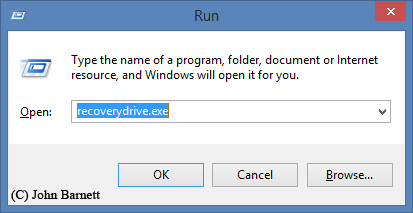
Fig: 8.16.1 Use the search
option to locate the Recovery Drive tool
- After clicking the OK
button on the Run dialogue box a User
Account Control box will appear
asking: Do you want to allow the
following program to make changes to this
computer.
- Press the Yes button to
continue.
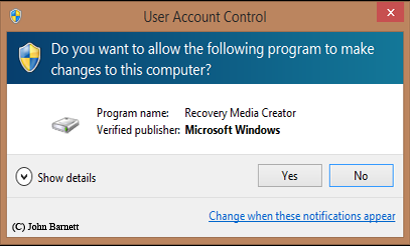
Fig 8.16.2 Click the OK
button to accept
- The Create a recovery drive
screen will now appear.
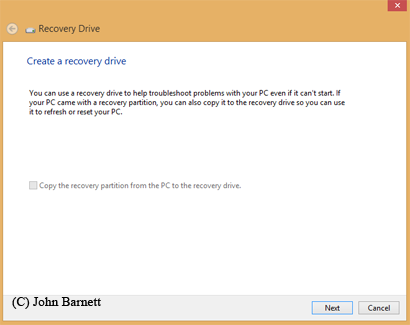
Fig 8.16.3 You can also copy
your OEM recover partition over to the new USB
recovery drive
- If you already have a recovery drive on your
PC, for example an OEM recovery partition, you
can ensure that this partition/drive is also
copied to the USB drive by placing a check mark
(tick) in the box next to the Copy
the recovery partition from this PC to the
recovery drive
option.
- To create the USB recovery drive, press the
Next button.
- In the next screen you need to connect a
suitable USB flash drive to your computer. The
screen below (Fig: 8.17.4) will also show you
what size USB drive you will need.
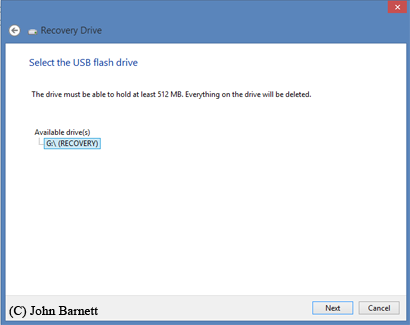
Fig 8.16.4 Insert a USB stick
into your computers' USB port
- Once you have inserted a USB stick into your
computers' USB port you will be warned that
if you proceed with the creation of
the USB recovery drive everything currently
stored on the USB stick will be permanently
deleted.
- If there are any files on the USB stick that
are important and that you need to keep please
ensure that you have a backup copy of the
file(s)otherwise, when you create the recovery
drive, any files already on the USB stick will
be automatically deleted.
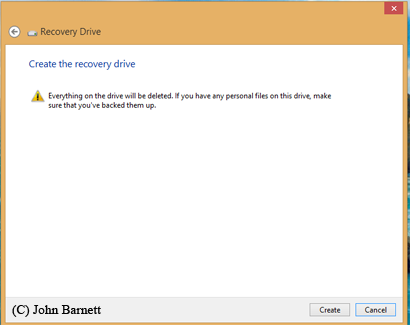
Fig: 8.16.5 Press the Create
button to start creating the recovery drive
- In order to proceed with the creation of the
USB recovery drive you now need to press the
Create button.
- Windows will now start to transfer the
recovery files to the USB stick.
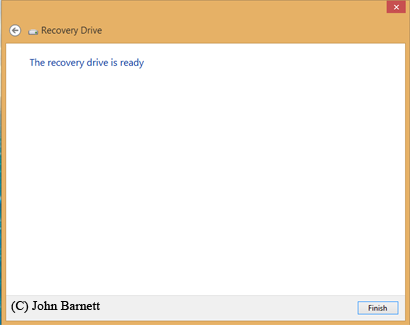
Fig: 8.16.6 The recovery
drive is now ready
- After a short while you will be notified
that the recovery drive is now ready.
- To check what files have been copied to your
USB stick, open up the Windows File
Explorer and navigate to your USB
recovery drive.
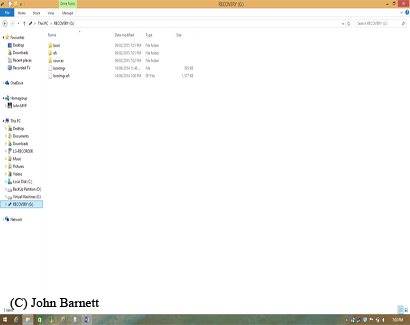
Fig: 8.16.7 Open the Windows
File Explorer and navigate to the USB recovery
drive
- Once the recovery drive has been completed
you can remove the USB stick and place it in a
safe place ready for when you need to use it.